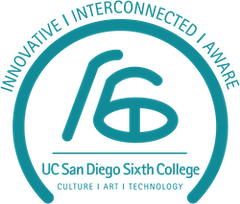CAT 3
CAT 3 courses (six units, spring quarter) are writing- and research-intensive, focusing on collaboration, research, and art-making by speculating on how the relationships between culture, art, and technology will be transformed in the future. Students must have passed CAT 2 in order to enroll in CAT 3.
Learning Objectives
After completing CAT 1 and CAT 2, CAT 3 students should be confident in their ability to do the following:
-
Understand and practice effective research, including developing research questions and finding and evaluating appropriate sources.
-
Use research to make an effective multimodal and/or creative argument towards a specific audience.
-
Engage with cultural products, including art and popular culture, as the result of research but also as legitimate objects of research.
-
Develop an collaborative research project: find and evaluate appropriate sources, compose research genres (such as annotated bibliographies and literature reviews, etc.), and practice revision.
-
Develop independence in the composition process and effectively collaborate with peers in the process of research and development of a multimodal project.
Writing Skills
CAT 3 fosters the following skills:
-
Intersectional approaches to research.
-
Writing with research and developing a voice.
-
Respectful and responsible collaboration (interpersonal communication).
-
Multimodal/creative composition.
Core Concepts
By the end of CAT 3, students should be able to understand and define the below terms and ideas:
-
Resistance/revolution.
-
Interdisciplinarity.
-
Art as argument.
-
Research as a process.
Common Readings
All CAT 3 students will read these texts:
-
Walter Benjamin: "Thesis on History."
-
Octavia Butler: "A Few Rules for Predicting the Future."
Spring 2025
CAT 3: What If?: Fearsome Futures and Possible Presents
Jennifer Marchisotto
Lecturer, CAT
Monday/Wednesday/Friday 10:00-10:50 a.m.
Imagination is subversive. Creators of speculative art have long used it to undermine power structures, providing alternative views of what our world could look like. This CAT 3 course will look at the ways creators use art to warn us of pending catastrophe or show us the possibility of a different present, directing our gaze to better understand contemporary experience by reflecting it in fantastic, fun, and sometimes horrifying ways. We will read, watch, and listen to texts that contemplate the ways ability, gender, race, and other elements of identity intersect with contemporary culture and the environment to say something about who we are and where we are going.
CAT 3: How to Survive the Zombie Future
Liz Popko
Assistant Teaching Professor, CAT
Monday/Wednesday/Friday 9:00-9:50 a.m.
In this CAT 3 course, you will use your research and analysis skills to speculate about a post-apocalyptic/dystopian zombie future. Specifically, you will use your own areas of expertise to imagine what kind of zombie future awaits us and offer insights into how we might manifest or avoid those destinies. We will look at the ways zombies have been imagined in fiction, film, and other texts, particularly as they are used to signal different anxieties about the past, present, and future world. Some questions that this class will consider include: What counts as a zombie? How does the zombie symbolize different kinds of human relationships and social organizations? What could be done now to prepare us for a world with zombies? What does ethics look like amidst a zombie crisis and catastrophe?
CAT 3: Translation
Amelia Glaser
Professor, Literature
Tuesday/Thursday 11:00 a.m.-12:20 p.m.
How have humans, from the ancient world to the present, made themselves understood across languages? What methods have proved the most effective and under what circumstances? This course seeks to answer these questions by examining innovations in translation from the Rosetta Stone, to Biblical translation, to web-based language technology. You will read essays and articles exploring the possibilities and impossibilities of translating jokes, slang, and terms of endearment. We will discuss how translators, the "work horses of literature," have sought to render poetry into different languages. We will test new technologies that are changing the way we approach foreign texts. In-class exercises will allow you to try your hand at a variety of translation techniques. You do not need to know a foreign language for this class, but if you do you might have a chance to use it.
CAT 3: Listening to the Future: Speculating through Soundscapes and Sonification
Joe Bigham
Lecturer, CAT
Tuesday/Thursday 9:30-10:50 a.m.
Speculation is a powerful tool that allows us to "see" the possibilities that lay before us. But what about the sounds of the future? Can the hum of electricity and droning of circuits be understood as the murmurs of a future still to come? How have artists used sound to give voice to their hopes and concerns? This CAT 3 course considers how we hear and make heard potential trajectories for people, technology, and culture through analysis and creation of sound.
This course engages with theories and ideas from a cross-section of disciplines, including Film Studies, Popular Music Studies, and Sound Studies. We start by considering the use of sound in science fiction film sound design and soundtracks, such as 2001: A Space Odyssey, The Matrix, and Arrival. We then turn to the types of messages and issues addressed by musicians with futurist and speculative aesthetics, such as Parliament/Funkadelic, Björk, and Janelle Monáe. Lastly, we focus on the sound worlds we are already immersed within and analyze what those sounds say about the present moment. Taken in total, these sounds, ideas, and analyses will serve as the basis for students' collaborative multimedia works that speculate through sound.
Writing Support
There are a variety of writing resources around campus for students to take advantage of. In addition to CAT TAs' office hours, students may visit the Writing Hub in the Teaching and Learning Commons for help with their writing assignments. The Office of Academic Support and Instructional Services (OASIS) also offers a variety of tutoring programs, including the Language Arts Tutorial Services (LATS).
